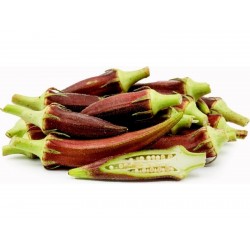Menu
-
MenuInapoi
- Home
-
Categorii
-
-
Categorii
-
Semințe de legume
-
Soiuri după țară
- Soiuri din Armenia
- Soiuri din BiH
- Soiuri din Croația
- Soiuri din Franța
- Varieties from Germany
- Varieties from Greece
- Varieties from Hungary
- Soiuri din India
- Varieties from Italy
- Soiuri din Japonia
- Soiuri din Macedonia de Nord
- Varieties from Peru
- Varieties from Russia
- Varieties from Serbia
- Soiuri din Slovenia
- Varieties from Spain
- Varieties from Thailand
- Soiuri din Turcia
- Varieties from USA
- Semințe de roșii
- Semințe de porumb
- Familia Dovleac
- Familia Bean
- Semințe de castraveți
- Seminte de ardei gras
- Familia morcovului
- Familia ceapa
- Semințe de salată verde
- Familia cartofilor
- Familia de varză
- Semințe de ridiche
- Familia sfeclei
- Semințe de pepene verde
- Semințe de pepene galben
- Semințe de conopidă
- Familia de floarea soarelui
-
Soiuri după țară
- Semințe de fructe
- Seminte de Chili Peppers
- Semințe de plante medicinale
- Semințe de plante cățărătoare
- Copaci - Arbust - Semințe
- Semințe de palmier
- Semințe de ierburi ornamentale
- Semințe de tutun
-
Semințe de legume
-
-
-
-
- PRODUSE NOI
- Crează un cont
- Livrare - Plata
- FAQ
- Acasa
-
- Pachete mari de semințe
- Semințe de plante uriașe
- Semințe de legume
- Soiuri după țară
- Soiuri din Armenia
- Soiuri din BiH
- Soiuri din Croația
- Soiuri din Franța
- Varieties from Germany
- Varieties from Greece
- Varieties from Hungary
- Soiuri din India
- Varieties from Italy
- Soiuri din Japonia
- Soiuri din Macedonia de Nord
- Varieties from Peru
- Varieties from Russia
- Varieties from Serbia
- Soiuri din Slovenia
- Varieties from Spain
- Varieties from Thailand
- Soiuri din Turcia
- Varieties from USA
- Semințe de roșii
- Semințe de porumb
- Familia Dovleac
- Familia Bean
- Semințe de castraveți
- Seminte de ardei gras
- Familia morcovului
- Familia ceapa
- Semințe de salată verde
- Familia cartofilor
- Familia de varză
- Semințe de ridiche
- Familia sfeclei
- Semințe de pepene verde
- Semințe de pepene galben
- Semințe de conopidă
- Familia de floarea soarelui
- Soiuri după țară
- Semințe de fructe
- Seminte de Chili Peppers
- Semințe de plante medicinale
- Semințe de plante cățărătoare
- Copaci - Arbust - Semințe
- Semințe de banane
- Semințe de palmier
- Semințe de ierburi ornamentale
- Semințe de tutun
- Semințe de flori
- Seminte cactus
- Apa plantează semințe
- Instrucțiuni de însămânțare
- Matrite pentru fructe și legume
- Miceliu de ciuperci
- Tuberculi de plante
- Semințe de bambus
- Plante Ayurveda
- Semințe hibride F1
- Ambalaje și altele
- Plante rezistente la frig
- Îngrijirea plantelor
- Condimente organice
- Livrare - Plata
- Fără PayPal și plata cu cardul X
Last Product Reviews
Out of the two seeds, one germinated and the other one was dead and floatin...
By
 Riikka H on 07/03/2024
Riikka H on 07/03/2024
Verified Purchase
Top vanzari
Sunt 1308 produse.
Se afiseaza 1246-1260 din 1308 produs(e)

Varietate din Italia
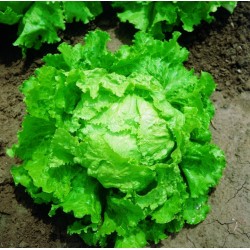
Lettuce Seeds BATAVIA...
Pret
1,85 €
(SKU: PL 5)
Seeds Gallery EU,
5/
5
<h2><strong>Lettuce Seeds BATAVIA BIONDA DI PARIGI</strong></h2>
<h2><span style="color: #ff0000;" class=""><strong>Price for Package of 1000 (1g) seeds.</strong></span></h2>
<p>Italian Heirloom Batavia Bionda Di Parigi is a medium-early variety that produces a large, and heavy head, which is crisp and golden. A large tightly wrapped round head with light green tender leaves and pronounced crunchy ribs.</p>
<p> </p>
<h3><strong>When to Plant</strong></h3>
<p>In spring, sow lettuce in cold frames or tunnels six weeks before your last frost date. Start more seeds indoors under lights at about the same time, and set them out when they are three weeks old. Direct seed more lettuce two weeks before your average last spring frost date. Lettuce seeds typically sprout in two to eight days when soil temperatures range between 55 and 75 degrees.</p>
<p> </p>
<p>In fall, sow all types of lettuce at two-week intervals starting eight weeks before your first fall frost. One month before your first frost, sow only cold-tolerant butterheads and romaines.</p>
<p> </p>
<h3><strong>How to Plant</strong></h3>
<p>Prepare your planting bed by loosening the soil to at least 10 inches deep. Mix in an inch or so of good compost or well-rotted manure. Sow lettuce seeds a quarter of an inch deep and 1 inch apart in rows or squares, or simply broadcast them over the bed.</p>
<p> </p>
<p>Indoors, sow lettuce seeds in flats or small containers kept under fluorescent lights. Harden off three-week-old seedlings for at least two or three days before transplanting. Use shade covers, such as pails or flowerpots, to protect transplants from sun and wind during their first few days in the garden.</p>
<p> </p>
<h3><strong>Harvesting and Storage</strong></h3>
<p>Harvest lettuce in the morning, after the plants have had all night to plump up with water. Wilted lettuce picked on a hot day seldom revives, even when rushed to the refrigerator. Pull (and eat) young plants until you get the spacing you want. Gather individual leaves or use scissors to harvest handfuls of baby lettuce. Rinse lettuce thoroughly with cool water, shake or spin off excess moisture, and store it in plastic bags in the refrigerator. Lettuce often needs a second cleaning as it is prepared for the table.</p><script src="//cdn.public.n1ed.com/G3OMDFLT/widgets.js"></script>
PL 5 (1g)

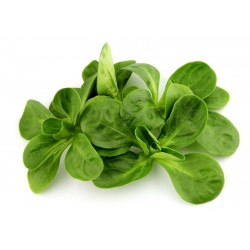
Corn Salad Seeds D'OLANDA A...
Pret
1,55 €
(SKU: PL 9)
Seeds Gallery EU,
5/
5
<h2><strong>Corn Salad Seeds D'OLANDA A SEME GROSSO</strong></h2>
<h2 class=""><span style="color: #ff0000;"><strong>Price for Package of 350 (1g) seeds.</strong></span></h2>
<p>Lamb’s lettuce in the UK, valeriana in Italy, corn salad in the USA and mache in France. Larger leaves than Cambrai, soft and tender texture with same great taste and cold resistance A favourite of those from cold climates where it was the first green salad vegetable to emerge from the melting snow. A delightful salad green that will only do well if grown when cold, but has great cold resistance. Direct seed in rows early spring and autumn and thin to 10cm.</p><script src="//cdn.public.n1ed.com/G3OMDFLT/widgets.js"></script>
PL 9 (1g)


Planta gigantica (cu fructe gigantice)
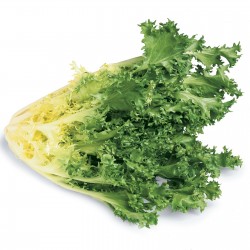
Endive Giant Seeds
Pret
1,65 €
(SKU: VE 187)
Seeds Gallery EU,
5/
5
<h2><span><em><strong><span style="text-decoration:underline;color:#000000;">ENDIVE GIANT SEEDS</span><br /></strong></em></span></h2>
<h3><span style="color:#ff0000;"><strong>Package of 100 seeds.</strong></span></h3>
<div>Beware! Once you acquire a taste for this interesting and attractive-looking salad plant, you will find salads based on the ubiquitous Lettuce insipid and dull. Although grown like Lettuce, it has the advantage that it will withstand without complaint both heat and a few degrees of frost. Best if blanched a few days before harvesting and - a personal opinion - tastes better with a home-made French dressing rather than salad cream out of a bottle. If you´ve never grown Endives, do give them a trial.</div>
VE 187 (100 S)

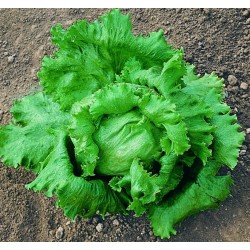
LETTUCE BRASILIANA Seeds
Pret
1,85 €
(SKU: PL 6)
Seeds Gallery EU,
5/
5
<h2><strong>LETTUCE BRASILIANA Seeds</strong></h2>
<h2><span style="color: #ff0000;"><strong>Price for Package of 100 seeds.</strong></span></h2>
<p>Brasiliana: Similar in nature to an Iceberg lettuce. Large, tightly wrapped head with crunchy leaves.</p>
<p>Lettuce (Lactuca sativa) is an annual plant of the daisy family Asteraceae. It is most often grown as a leaf vegetable, but sometimes for its stem and seeds. Lettuce was first cultivated by the ancient Egyptians who turned it from a weed, whose seeds were used to produce oil, into a food plant grown for its succulent leaves, in addition to its oil-rich seeds. Lettuce spread to the Greeks and Romans, the latter of whom gave it the name lactuca, from which the English lettuce is ultimately derived. By 50 AD, multiple types were described, and lettuce appeared often in medieval writings, including several herbals. The 16th through 18th centuries saw the development of many varieties in Europe, and by the mid-18th century cultivars were described that can still be found in gardens. Europe and North America originally dominated the market for lettuce, but by the late 20th century the consumption of lettuce had spread throughout the world.</p>
<p>Generally grown as a hardy annual, lettuce is easily cultivated, although it requires relatively low temperatures to prevent it from flowering quickly. It can be plagued with numerous nutrient deficiencies, as well as insect and mammal pests and fungal and bacterial diseases. L. sativa crosses easily within the species and with some other species within the Lactuca genus; although this trait can be a problem to home gardeners who attempt to save seeds, biologists have used it to broaden the gene pool of cultivated lettuce varieties. World production of lettuce and chicory for calendar year 2010 stood at 23 620 000/23,620,000 tonnes, half of which came from China.</p>
<p>Lettuce is most often used for salads, although it is also seen in other kinds of food, such as soups, sandwiches and wraps; it can also be grilled.[3] One variety, the woju (莴苣), or asparagus lettuce, is grown for its stems, which are eaten either raw or cooked. Lettuce is a rich source of vitamin K and vitamin A, and is a moderate source of folate and iron. Contaminated lettuce is often a source of bacterial, viral and parasitic outbreaks in humans, including E. coli and Salmonella. In addition to its main use as a leafy green, it has also gathered religious and medicinal significance over centuries of human consumption.</p>
<p><strong>Taxonomy and etymology</strong></p>
<p>Lactuca sativa is a member of the Lactuca (lettuce) genus and the Asteraceae (sunflower or aster) family.[4] The species was first described in 1753 by Carl Linnaeus in the second volume of his Species Plantarum.[5] Synonyms for L. sativa include Lactuca scariola var. sativa,[1] L. scariola var. integrata and L. scariola var. integrifolia.[6] L. scariola is itself a synonym for L. serriola, the common wild or prickly lettuce.[2] L. sativa also has many identified taxonomic groups, subspecies and varieties, which delineate the various cultivar groups of domesticated lettuce.[7] Lettuce is closely related to several Lactuca species from southwest Asia; the closest relationship is to L. serriola, an aggressive weed common in temperate and subtropical zones in much of the world.</p>
<p>The Romans referred to lettuce as lactuca (lac meaning milk in Latin), an allusion to the white substance, now called latex, exuded by cut stems.[9] This word has become the genus name, while sativa (meaning "sown" or "cultivated") was added to create the species name.[10] The current word lettuce, originally from Middle English, came from the Old French letues or laitues, which derived from the Roman name.[11] The name romaine came from that type's use in the Roman papal gardens, while cos, another term for romaine lettuce, came from the earliest European seeds of the type from the Greek island of Cos, a center of lettuce farming in the Byzantine period.</p>
<p><strong>Description</strong></p>
<p>Lettuce's native range spreads from the Mediterranean to Siberia, although it has been transported to almost all areas of the world. Plants generally have a height and spread of 6 to 12 inches (15 to 30 cm). The leaves are colorful, mainly in the green and red color spectrums, with some variegated varieties. There are also a few varieties with yellow, gold or blue-teal leaves. Lettuces have a wide range of shapes and textures, from the dense heads of the iceberg type to the notched, scalloped, frilly or ruffly leaves of leaf varieties.[14] Lettuce plants have a root system that includes a main taproot and smaller secondary roots. Some varieties, especially those found in the United States and Western Europe, have long, narrow taproots and a small set of secondary roots. Longer taproots and more extensive secondary systems are found in varieties from Asia.</p>
<p>Depending on the variety and time of year, lettuce generally lives 65–130 days from planting to harvesting. Because lettuce that flowers (through the process known as "bolting") becomes bitter and unsaleable, plants grown for consumption are rarely allowed to grow to maturity. Lettuce flowers more quickly in hot temperatures, while freezing temperatures cause slower growth and sometimes damage to outer leaves.[16] Once plants move past the edible stage, they develop flower stalks up to 3 feet (0.9 m) high with small yellow blossoms.[17] Like other members of the tribe Cichorieae, lettuce inflorescences (also known as flower heads or capitula) are composed of multiple florets, each with a modified calyx called a pappus (which becomes the feathery "parachute" of the fruit), a corolla of five petals fused into a ligule or strap, and the reproductive parts. These include fused anthers that form a tube which surrounds a style and bipartite stigma. As the anthers shed pollen, the style elongates to allow the stigmas, now coated with pollen, to emerge from the tube.[15][18] The ovaries form compressed, obovate (teardrop-shaped) dry fruits that do not open at maturity, measuring 3 to 4 mm long. The fruits have 5–7 ribs on each side and are tipped by two rows of small white hairs. The pappus remains at the top of each fruit as a dispersal structure. Each fruit contains one seed, which can be white, yellow, gray or brown depending on the variety of lettuce.</p>
<p>The domestication of lettuce over the centuries has resulted in several changes through selective breeding: delayed bolting, larger seeds, larger leaves and heads, better taste and texture, a lower latex content, and different leaf shapes and colors. Work in these areas continues through the present day.[19] Scientific research into the genetic modification of lettuce is ongoing, with over 85 field trials taking place between 1992 and 2005 in the European Union and United States to test modifications allowing greater herbicide tolerance, greater resistance to insects and fungi and slower bolting patterns. However, genetically modified lettuce is not currently used in commercial agriculture.</p>
<p><strong>History</strong></p>
<p>Lettuce was first cultivated in ancient Egypt for the production of oil from its seeds. This plant was probably selectively bred by the Egyptians into a plant grown for its edible leaves,[21] with evidence of its cultivation appearing as early as 2680 BC.[9] Lettuce was considered a sacred plant of the reproduction god Min, and it was carried during his festivals and placed near his images. The plant was thought to help the god "perform the sexual act untiringly."[22] Its use in religious ceremonies resulted in the creation of many images in tombs and wall paintings. The cultivated variety appears to have been about 30 inches (76 cm) tall and resembled a large version of the modern romaine lettuce. These upright lettuces were developed by the Egyptians and passed to the Greeks, who in turn shared them with the Romans. Circa 50 AD, Roman agriculturalist Columella described several lettuce varieties – some of which may have been ancestors of today's lettuces.</p>
<p>Lettuce appears in many medieval writings, especially as a medicinal herb. Hildegard of Bingen mentioned it in her writings on medicinal herbs between 1098 and 1179, and many early herbals also describe its uses. In 1586, Joachim Camerarius provided descriptions of the three basic modern lettuces – head lettuce, loose-leaf lettuce, and romaine (or cos) lettuce.[12] Lettuce was first brought to the Americas from Europe by Christopher Columbus in the late 15th century.[23][24] Between the late 16th century and the early 18th century, many varieties were developed in Europe, particularly Holland. Books published in the mid-18th and early 19th centuries describe several varieties found in gardens today.</p>
<p>Due to its short lifespan after harvest, lettuce was originally sold relatively close to where it was grown. The early 20th century saw the development of new packing, storage and shipping technologies that improved the lifespan and transportability of lettuce and resulted in a significant increase in availability.[26] During the 1950s, lettuce production was revolutionized with the development of vacuum cooling, which allowed field cooling and packing of lettuce, replacing the previously used method of ice-cooling in packing houses outside the fields.</p>
<p>Lettuce is very easy to grow, and as such has been a significant source of sales for many seed companies. Tracing the history of many varieties is complicated by the practice of many companies, particularly in the US, of changing a variety's name from year to year. This was done for several reasons, the most prominent being to boost sales by promoting a "new" variety or to prevent customers from knowing that the variety had been developed by a competing seed company. Documentation from the late 19th century shows between 65 and 140 distinct varieties of lettuce, depending on the amount of variation allowed between types – a distinct difference from the 1,100 named lettuce varieties on the market at the time. Names also often changed significantly from country to country.[28] Although most lettuce grown today is used as a vegetable, a minor amount is used in the production of tobacco-free cigarettes; however, domestic lettuce's wild relatives produce a leaf that visually more closely resembles tobacco.</p>
<p><strong>Cultivation</strong></p>
<p>A hardy annual, some varieties of lettuce can be overwintered even in relatively cold climates under a layer of straw, and older, heirloom varieties are often grown in cold frames.[25] Lettuces meant for the cutting of individual leaves are generally planted straight into the garden in thick rows. Heading varieties of lettuces are commonly started in flats, then transplanted to individual spots, usually 8 to 14 inches (20 to 36 cm) apart, in the garden after developing several leaves. Lettuce spaced further apart receives more sunlight, which improves color and nutrient quantities in the leaves. Pale to white lettuce, such as the centers in some iceberg lettuce, contain few nutrients.</p>
<p>Lettuce grows best in full sun in loose, nitrogen-rich soils with a pH of between 6.0 and 6.8. Heat generally prompts lettuce to bolt, with most varieties growing poorly above 75 °F (24 °C); cool temperatures prompt better performance, with 60 to 65 °F (16 to 18 °C) being preferred and as low as 45 °F (7 °C) being tolerated.[30] Plants in hot areas that are provided partial shade during the hottest part of the day will bolt more slowly. Temperatures above 80 °F (27 °C) will generally result in poor or non-existent germination of lettuce seeds.[30] After harvest, lettuce lasts the longest when kept at 32 °F (0 °C) and 96 percent humidity. Lettuce quickly degrades when stored with fruit such as apples, pears and bananas that release the ripening agent ethylene gas. The high water content of lettuce (94.9 percent) creates problems when attempting to preserve the plant – it cannot be successfully frozen, canned or dried and must be eaten fresh.</p>
<p>Lettuce varieties will cross with each other, making spacing of 5 to 20 feet (1.5 to 6.1 m) between varieties necessary to prevent contamination when saving seeds. Lettuce will also cross with Lactuca serriola (wild lettuce), with the resulting seeds often producing a plant with tough, bitter leaves. Celtuce, a lettuce variety grown primarily in Asia for its stems, crosses easily with lettuces grown for their leaves.[17] This propensity for crossing, however, has led to breeding programs using closely related species in Lactuca, such as L. serriola, L. saligna, and L. virosa, to broaden the available gene pool. Starting in the 1990s, such programs began to include more distantly related species such as L. tatarica.[32] Seeds keep best when stored in cool conditions, and, unless stored cryogenically, remain viable the longest when stored at −4 °F (−20 °C); they are relatively short lived in storage.</p>
<p>At room temperature, lettuce seeds remain viable for only a few months. However, when newly harvested lettuce seed is stored cryogenically, this life increases to a half-life of 500 years for vaporized nitrogen and 3,400 years for liquid nitrogen; this advantage is lost if seeds are not frozen promptly after harvesting.</p>
<p><strong>Culinary use</strong></p>
<p>As described around 50 AD, lettuce leaves were often cooked and served by the Romans with an oil-and-vinegar dressing; however, smaller leaves were sometimes eaten raw. During the 81–96 AD reign of Domitian, the tradition of serving a lettuce salad before a meal began. Post-Roman Europe continued the tradition of poaching lettuce, mainly with large romaine types, as well as the method of pouring a hot oil and vinegar mixture over the leaves.[9] Today, the majority of lettuce is grown for its leaves, although one type is grown for its stem and one for its seeds, which are made into an oil.[21] Most lettuce is used in salads, either alone or with other greens, vegetables, meats and cheeses. Romaine lettuce is often used for Caesar salads, with a dressing that includes anchovies and eggs. Lettuce leaves can also be found in soups, sandwiches and wraps, while the stems are eaten both raw and cooked.[10] The consumption of lettuce in China developed differently from in Western countries, due to health risks and cultural aversion to eating raw leaves. In that country, "salads" were created from cooked vegetables and served hot or cold. Lettuce was also used in a larger variety of dishes than in Western countries, contributing to a range of dishes including bean curd and meat dishes, soups and stir-frys plain or with other vegetables. Stem lettuce, widely consumed in China, is eaten either raw or cooked, the latter primarily in soups and stir-frys.[44] Lettuce is also used as a primary ingredient in the preparation of lettuce soup.</p>
<p><strong>Nutritional content</strong></p>
<p>Depending on the variety, lettuce is an excellent source (20% of the Daily Value, DV, or higher) of vitamin K (97% DV) and vitamin A (21% DV) (table), with higher concentrations of the provitamin A compound, beta-carotene, found in darker green lettuces, such as Romaine.[31] With the exception of the iceberg variety, lettuce is also a good source (10-19% DV) of folate and iron (table).</p>
<p><strong>Religious and medicinal lore</strong></p>
<p>In addition to its usual purpose as an edible leafy vegetable, lettuce has had a number of uses in ancient (and even some more modern) times as a medicinal herb and religious symbol. For example, ancient Egyptians thought lettuce to be a symbol of sexual prowess[43] and a promoter of love and childbearing in women. The Romans likewise claimed that it increased sexual potency.[52] In contrast, the ancient Greeks connected the plant with male impotency,[9] and served it during funerals (probably due to its role in the myth of Adonis's death), and British women in the 19th century believed it would cause infertility and sterility. Lettuce has mild narcotic properties; it was called "sleepwort" by the Anglo-Saxons because of this attribute, although the cultivated L. sativa has lower levels of the narcotic than its wild cousins.[52] This narcotic effect is a property of two sesquiterpene lactones which are found in the white liquid (latex) in the stems of lettuce,[29] called lactucarium or "lettuce opium".</p>
<p>Lettuce is also eaten as part of the Jewish Passover Seder, where it is considered the optimal choice for use as the bitter herb, which is eaten together with the matzah.</p>
<p>Some American settlers claimed that smallpox could be prevented through the ingestion of lettuce,[52] and an Iranian belief suggested consumption of the seeds when afflicted with typhoid.[53] Folk medicine has also claimed it as a treatment for pain, rheumatism, tension and nervousness, coughs and insanity; scientific evidence of these benefits in humans has not been found. The religious ties of lettuce continue into the present day among the Yazidi people of northern Iraq, who have a religious prohibition against eating the plant.</p>
PL 6 (100 S)

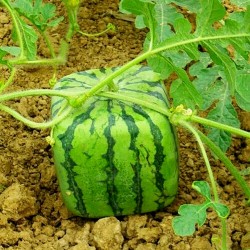
How to Grow a Square...
Pret
0,95 €
(SKU: HTGSW)
Seeds Gallery EU,
5/
5
<meta http-equiv="Content-Type" content="text/html; charset=UTF-8" />
<div id="idTab1" class="rte">
<h2><strong>How to Grow a Square Watermelon</strong></h2>
<p>Here you can buy and download a PDF manual ( with pictures ) How to Grow a Square Watermelon.<br />Manuals are available following languages:<br />Deutsch <br />English <br />Español <br />France <br />Italiano <br />Português <br />Srpski</p>
</div>
HTGSW


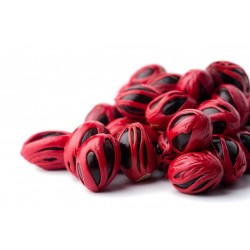
Nutmeg Seeds - Aphrodisiac
Pret
4,95 €
(SKU: T 54)
Seeds Gallery EU,
5/
5
<div id="idTab1" class="rte">
<h2><span style="font-size: 14pt;"><strong>Nutmeg Seeds - Aphrodisiac (Myristica Fragrans)</strong></span></h2>
<h2><span style="color: #ff0000; font-size: 14pt;"><strong>Price for Package of 1 or 2 seeds.</strong></span></h2>
<p>The Nutmeg fruit is similar in appearance to an apricot. When fully mature it splits in two, exposing a crimson-colored edible pulp surrounding a single seed, the nutmeg.<</p>
<p>Nutmeg - the spice consisting of the seed has a characteristic, pleasant fragrance and slightly warm taste; it is used to flavor many kinds of baked goods, confections, puddings, meats, sausages, sauces, vegetables, and such beverages as eggnog.</p>
<p> Nutmeg spice comes from the dried endosperm inside the seed of the Nutmeg tree (Myristica fragrans), a member of the myristica family (Myristicaceae).</p>
<p>Nutmeg is not a nut, but the kernel of an apricot-like fruit. Mace is an arillus, a thin leathery tissue between the stone and the pulp; it is bright red to purple when harvested, but after drying changes to amber.</p>
<p> Both spices are strongly aromatic, resinous and warm in taste. Mace is generally said to have a finer aroma than nutmeg, but the difference is small. Nutmeg quickly loses its fragrance when ground; therefore, the necessary amount should be grated from a whole nut immediately before usage.</p>
<p><strong><em><span style="text-decoration: underline;">The red mace will be removed and the nut will not be red but black. The brown seed inside this nut.</span></em></strong></p>
<p><strong>Wikipedia:</strong></p>
<p>The nutmeg tree is any of several species of trees in genus Myristica. The most important commercial species is Myristica fragrans, an evergreen tree indigenous to the Banda Islands in the Moluccas (or Spice Islands) of Indonesia. The nutmeg tree is important for two spices derived from the fruit: nutmeg and mace.[1]</p>
<p>Nutmeg is the seed of the tree, roughly egg-shaped and about 20 to 30 mm (0.8 to 1.2 in) long and 15 to 18 mm (0.6 to 0.7 in) wide, and weighing between 5 and 10 g (0.2 and 0.4 oz) dried, while mace is the dried "lacy" reddish covering or aril of the seed. The first harvest of nutmeg trees takes place 7–9 years after planting, and the trees reach full production after 20 years. Nutmeg is usually used in powdered form. This is the only tropical fruit that is the source of two different spices. Several other commercial products are also produced from the trees, including essential oils, extracted oleoresins, and nutmeg butter (see below).</p>
<p>The common or fragrant nutmeg, Myristica fragrans, native to the Banda Islands of Indonesia, is also grown in Penang Island in Malaysia and the Caribbean, especially in Grenada. It also grows in Kerala, a state in southern India. Other species of nutmeg include Papuan nutmeg M. argentea from New Guinea, and M. malabarica from India.</p>
<p><strong>Botany and cultivation</strong></p>
<p>Nutmeg is a dioecious plant which is propagated sexually and asexually, the latter being the standard. Sexual propagation by seedling yields 50% male seedlings, which are unproductive. As there is no reliable method of determining plant sex before flowering in the sixth to eighth year, and sexual propagation bears inconsistent yields, grafting is the preferred method of propagation. Epicotyl grafting, approach grafting and patch budding have proved successful, epicotyl grafting being the most widely adopted standard. Air-layering, or marcotting, is an alternative, though not preferred, method, because of its low (35-40%) success rate.</p>
<p><strong>Culinary uses</strong></p>
<p>Nutmeg and mace have similar sensory qualities, with nutmeg having a slightly sweeter and mace a more delicate flavour. Mace is often preferred in light dishes for the bright orange, saffron-like hue it imparts. Nutmeg is used for flavouring many dishes, usually in ground or grated form, and is best grated fresh in a nutmeg grater.</p>
<p>In Penang cuisine, dried, shredded nutmeg rind with sugar coating is used as toppings on the uniquely Penang ais kacang. Nutmeg rind is also blended (creating a fresh, green, tangy taste and white colour juice) or boiled (resulting in a much sweeter and brown juice) to make iced nutmeg juice.</p>
<p>In Indian cuisine, nutmeg is used in many sweet as well as savoury dishes (predominantly in Mughlai cuisine). It is also added in small quantities as a medicine for infants. It may also be used in small quantities in garam masala. Ground nutmeg is also smoked in India.[citation needed]</p>
<p>In Indonesian cuisine, nutmeg is used in various dishes, mainly in many soups, such as soto soup, baso soup or Sup Kambing. It is also made as sweets.</p>
<p>In Middle Eastern cuisine, ground nutmeg is often used as a spice for savoury dishes.</p>
<p>In originally European cuisine, nutmeg and mace are used especially in potato dishes and in processed meat products; they are also used in soups, sauces, and baked goods. In Dutch cuisine, nutmeg is added to vegetables such as Brussels sprouts, cauliflower, and string beans. Nutmeg is a traditional ingredient in mulled cider, mulled wine, and eggnog.</p>
<p>Japanese varieties of curry powder include nutmeg as an ingredient.</p>
<p>In the Caribbean, nutmeg is often used in drinks such as the Bushwacker, Painkiller, and Barbados rum punch. Typically, it is just a sprinkle on the top of the drink.</p>
<p>The pericarp (fruit/pod) is used in Grenada and also in Indonesia to make jam, or is finely sliced, cooked with sugar, and crystallised to make a fragrant candy.</p>
<p>In Scotland, mace and nutmeg are usually both essential ingredients in haggis.</p>
<p><strong>Essential oils</strong></p>
<p>The essential oil obtained by steam distillation of ground nutmeg is used widely in the perfumery and pharmaceutical industries. This volatile fraction typically contains 60-80% d-camphene by weight, as well as quantities of d-pinene, limonene, d-borneol, l-terpineol, geraniol, safrol, and myristicin.[5] The oil is colourless or light yellow, and smells and tastes of nutmeg. It contains numerous components of interest to the oleochemical industry, and is used as a natural food flavouring in baked goods, syrups, beverages, and sweets. It is used to replace ground nutmeg, as it leaves no particles in the food. The essential oil is also used in the cosmetic and pharmaceutical industries, for instance, in toothpaste, and as a major ingredient in some cough syrups. In traditional medicine, nutmeg and nutmeg oil were used for disorders related to the nervous and digestive systems.</p>
<p>After extraction of the essential oil, the remaining seed, containing much less flavour, is called "spent". Spent is often mixed in industrial mills with pure nutmeg to facilitate the milling process, as nutmeg is not easy to mill due to the high percentage of oil in the pure seed. Ground nutmeg with a variable percentage of spent (around 10% w/w) is also less likely to clot. To obtain a better running powder also a small percentage of rice flour can be added.[citation needed]</p>
<p><strong>Nutmeg butter</strong></p>
<p>Nutmeg butter is obtained from the nut by expression. It is semi-solid, reddish brown in colour, and tastes and smells of nutmeg. Approximately 75% (by weight) of nutmeg butter is trimyristin, which can be turned into myristic acid, a 14-carbon fatty acid, which can be used as a replacement for cocoa butter, can be mixed with other fats like cottonseed oil or palm oil, and has applications as an industrial lubricant.</p>
<p><strong>History</strong></p>
<p>It is known to have been a prized costly spice in European medieval cuisine as a flavouring, medicinal, and preservative agent. Saint Theodore the Studite (ca. 758 – ca. 826) allowed his monks to sprinkle nutmeg on their pease pudding when required to eat it. In Elizabethan times, it was believed nutmeg could ward off the plague, so nutmeg became very popular and its price skyrocketed.[6]</p>
<p>The small Banda Islands were, until the mid-19th century, the world's only source of nutmeg and mace. Nutmeg is noted as a very valuable commodity by Muslim sailors from the port of Basra, such as Sinbad the Sailor in the One Thousand and One Nights. Nutmeg was traded by Arabs during the Middle Ages and sold to the Venetians for very high prices, but the traders did not divulge the exact location of their source in the profitable Indian Ocean trade, and no European was able to deduce their location.</p>
<p>In August 1511, Afonso de Albuquerque conquered Malacca, which at the time was the hub of Asian trade, on behalf of the king of Portugal. In November of that year, after having secured Malacca and learning of the Bandas' location, Albuquerque sent an expedition of three ships led by his friend António de Abreu to find them. Malay pilots, either recruited or forcibly conscripted, guided them via Java, the Lesser Sundas and Ambon to Banda, arriving in early 1512.[7] The first Europeans to reach the Bandas, the expedition remained in Banda for about a month, purchasing and filling their ships with Banda's nutmeg and mace, and with cloves in which Banda had a thriving entrepôt trade.[8] The first written accounts of Banda are in Suma Oriental, a book written by the Portuguese apothecary Tomé Pires, based in Malacca from 1512 to 1515. Full control of this trade by the Portuguese was not possible, and they remained participants without a foothold in the islands themselves.</p>
<p>The trade in nutmeg later became dominated by the Dutch in the 17th century. The English and Dutch engaged in prolonged struggles to gain control of Run Island, then the only source of nutmeg. At the end of the Second Anglo-Dutch War, the Dutch gained control of Run, while England controlled New Amsterdam (New York) in North America.</p>
<p>The Dutch waged a bloody war, including the massacre and enslavement of the inhabitants of the island of Banda, just to control nutmeg production in the East Indies in 1621. Thereafter, the Banda Islands were run as a series of plantation estates, with the Dutch mounting annual expeditions in local war-vessels to extirpate nutmeg trees planted elsewhere.</p>
<p>In 1760, the price of nutmeg in London was 85 to 90 shillings per pound, a price kept artificially high by the Dutch voluntarily burning full warehouses of nutmegs in Amsterdam.</p>
<p>As a result of the Dutch interregnum during the Napoleonic Wars, the British took temporary control of the Banda Islands from the Dutch and transplanted nutmeg trees (complete with soil) to Sri Lanka, to Penang, to Bencoolen and to Singapore.[9] However, there is evidence that the tree existed in Sri Lanka prior to this.[10] Thence they were transplanted to their other colonial holdings elsewhere, notably Zanzibar and Grenada. The national flag of Grenada, adopted in 1974, shows a stylised split-open nutmeg fruit. The Dutch however continued to hold control of the spice islands until World War II.</p>
<p>Connecticut gets its nickname ("the Nutmeg State", "Nutmegger") from the legend that some unscrupulous Connecticut traders would whittle "nutmeg" out of wood, creating a "wooden nutmeg" (a term which came to mean any fraud).</p>
<p><strong>World production</strong></p>
<p>World production of nutmeg is estimated to average between 10,000 and 12,000 tonnes (9,800 and 12,000 long tons; 11,000 and 13,000 short tons) per year, with annual world demand estimated at 9,000 tonnes (8,900 long tons; 9,900 short tons); production of mace is estimated at 1,500 to 2,000 tonnes (1,500 to 2,000 long tons; 1,700 to 2,200 short tons). Indonesia and Grenada dominate production and exports of both products, with world market shares of 75% and 20% respectively. Other producers include India, Malaysia (especially Penang, where the trees grow wild within untamed areas[citation needed]), Papua New Guinea, Sri Lanka, and Caribbean islands, such as St. Vincent and Grenada, which produces 20% of the world's nutmeg supply. The principal import markets are the European Community, the United States, Japan and India. Singapore and the Netherlands are major re-exporters.</p>
<p><strong>Medical research</strong></p>
<p>Nutmeg has been used in medicine since at least the seventh century. In the 19th century it was used as an abortifacient, which led to numerous recorded cases of nutmeg poisoning. Although used as a folk treatment for other ailments, unprocessed nutmeg has no proven medicinal value today.[12]</p>
<p>One study has shown that the compound macelignan isolated from Myristica fragrans (Myristicaceae) may exert antimicrobial activity against Streptococcus mutans,[13] and another that a methanolic extract from the same plant inhibited Jurkat cell activity in human leukemia,[14] but these are not currently used treatments.</p>
<p>Psychoactivity and toxicity</p>
<p><strong>Effects</strong></p>
<p>In low doses, nutmeg produces no noticeable physiological or neurological response, but in large doses, raw nutmeg has psychoactive effects. In its freshly ground (from whole nutmegs) form, nutmeg contains myristicin, a monoamine oxidase inhibitor and psychoactive substance. Myristicin poisoning can induce convulsions, palpitations, nausea, eventual dehydration, and generalized body pain.[15] It is also reputed to be a strong deliriant.[16]</p>
<p>Fatal myristicin poisonings in humans are very rare, but two have been reported: one in an 8-year-old child[17] and another in a 55-year-old adult, the latter case attributed to a combination with flunitrazepam.</p>
<p>In case reports raw nutmeg produced anticholinergic-like symptoms, attributed to myristicin and elemicin.</p>
<p>In case reports intoxications with nutmeg had effects that varied from person to person, but were often reported to be an excited and confused state with headaches, nausea and dizziness, dry mouth, bloodshot eyes and memory disturbances. Nutmeg was also reported to induce hallucinogenic effects, such as visual distortions and paranoid ideation. In the reports nutmeg intoxication took several hours before maximum effect was reached. Effects and after-effects lasted up to several days.</p>
<p>Myristicin poisoning is potentially deadly to some pets and livestock, and may be caused by culinary quantities of nutmeg harmless to humans. For this reason, it is recommended not to feed eggnog to dogs.[30]</p>
<p><strong>History of use</strong></p>
<p>Peter Stafford's Psychedelics Encyclopedia quotes an 1883 report from Mumbai noting that "the Hindus of West India take nutmeg as an intoxicant", and records that the spice has been used for centuries as a form of snuff in rural eastern Indonesia and India, latter seeing the ground seed mixed with betel and other kinds of snuff. In 1829, the Czech physiologist Jan Evangelista Purkinje ingested three ground nutmegs with a glass of wine and recorded headaches, nausea, hallucinations and a sense of euphoria that lasted for several days.[12]</p>
<p>Harvard ethnobotanist Richard Evans Schultes and chemist Albert Hofmann, who discovered LSD, documented reports of nutmeg's use as an intoxicant by students, prisoners, sailors, alcoholics and marijuana smokers. In his autobiography, Malcolm X writes about taking nutmeg and other "semi-drugs" while serving time in prison.[12]</p>
<p>The Angewandte Chemie International Edition records the use of nutmeg as an intoxicant in the United States in the post-World War II period, notably among young people, bohemians, and prisoners. A 1966 New York Times piece named it along with morning glory seeds, diet aids, cleaning fluids, cough medicine, and other substances as "alternative highs" on college campuses.[12]</p>
<p><strong>Toxicity during pregnancy</strong></p>
<p>Nutmeg was once considered an abortifacient, but may be safe for culinary use during pregnancy. However, it inhibits prostaglandin production and contains hallucinogens that may affect the fetus if consumed in large quantities.</p>
</div>
T 54 (1S)


Plantă medicinală sau condimentată

Planta rezistenta la frig si inghet
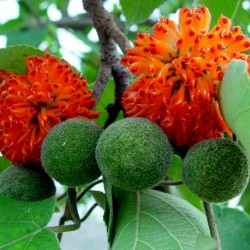
PAPER MULBERRY Seeds...
Pret
1,85 €
(SKU: T 55)
Seeds Gallery EU,
5/
5
<div id="idTab1" class="rte">
<h2><span style="font-size: 14pt;"><strong>PAPER MULBERRY Seeds (Broussonetia papyrifera)</strong></span></h2>
<h2><span style="color: #ff0000; font-size: 14pt;"><strong>Price for Package of 5 seeds.</strong></span></h2>
<p>The paper mulberry (Broussonetia papyrifera, syn. Morus papyrifera L.) is a species of flowering plant in the family Moraceae. It is native to Asia, where its range includes China, Japan, Korea, Laos, Cambodia, Thailand, Burma, and India. It is widely cultivated elsewhere and it grows as an introduced species in parts of Europe, the United States, and Africa. Other common names include tapa cloth tree.</p>
<p><strong>Description</strong></p>
<p>This species is a deciduous shrub or tree usually growing 10 to 20 meters tall, but known to reach 35 meters at times. The leaves are variable in shape, even on one individual. The blades may be lobed or unlobed, but they usually have toothed edges, lightly hairy, pale undersides, and a rough texture. They are up to about 15 to 20 centimeters long. The species is dioecious, with male and female flowers on separate plants. The staminate inflorescence is a catkin up to 8 centimeters long with fuzzy male flowers. The pistillate inflorescence is a spherical head up to about 2 centimeters wide with greenish female flowers trailing long styles. The infructescence is a spherical cluster 2 to 3 centimeters wide containing many red or orange fruits. Each individual protruding fruit in the cluster is a drupe.</p>
<p><strong>Uses</strong></p>
<p>This plant has been cultivated in Asia and some Pacific Islands for many centuries for food, fiber, and medicine. It is a significant fiber crop in the history of paper. It was used for papermaking in China by around 100 AD. It was used to make washi in Japan by 600 AD. Washi, a Japanese handcrafted paper, is made with the inner bark, which is pounded and mixed with water to produce a paste, which is dried into sheets.</p>
<p>Tapa cloth is a textile made from the inner bark in many Pacific Island nations. It was the main material for clothing in places such as Fiji, Tonga, Samoa and Tahiti until recent times, and it is still worn ceremonially. It is also used to make bags and bedding.</p>
<p>The wood of the plant is useful for making furniture and utensils, and the roots can be used as rope.</p>
<p>The fruits and cooked leaves are edible.</p>
<p>The fruit, leaves, and bark have been used in systems of traditional medicine. For example, the bark and fruit of the species, known locally as jangli toot, are used as a laxative and antipyretic in rural Pakistan.</p>
<p>The species is used as an ornamental plant. It tolerates disturbance and air pollution, so it has been useful as a landscaping plant on roadsides. It is a pioneer species that easily fills forest clearings, and it has been considered for reforestation efforts. It grows well in many climate types.</p>
<p><strong>Impacts</strong></p>
<p>The ability of the plant to readily colonize available habitat, particularly disturbed areas, has helped it become an invasive species in some regions. It spreads rapidly when male and female individuals grow together and seeds are produced. Seed dispersal is accomplished by animals that eat the fruits, and the plants can form wide, dense stands via their spreading root systems.</p>
<p>This is considered to be one of the worst weeds in Pakistan, one of the most significant invasive plants on the Pampas in Argentina, and a dominant invasive in the forests of Uganda.</p>
<p>The pollen is allergenic. It is reportedly a main culprit of inhalant allergy in Islamabad, where the species is a very common urban weed.</p>
</div>
T 55


Varietate din Statele Unite ale Americii
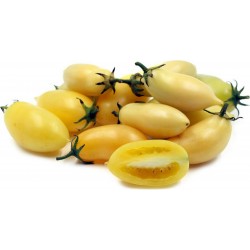
Cream Sausage Tomato Seeds
Pret
1,65 €
(SKU: VT 105)
Seeds Gallery EU,
5/
5
<h2 class=""><strong>Cream Sausage Tomato Seeds</strong></h2>
<h2><span style="color: #ff0000;"><strong>Price for Package of 5 seeds.</strong></span></h2>
<p>Cream Sausage tomatoes are long and cylindrical, typically harvested at around three inches, with the ivory-yellow outer skin. Their meaty inner flesh is very juicy, offering a sweet tomato flavor that is slightly acidic and tangy. The Cream Sausage tomato plant is a determinate, or bush, variety, meaning that it sets fruit all at once, and it is known to be an extremely productive cultivar. No staking or caging is needed for this easy-to-grow, bushy little 100 cm plant that bears fruit in clusters of about six.</p>
<p><strong>Current Facts</strong><br>The Cream Sausage tomato is an heirloom variety Roma, or paste, tomato. Tomatoes, originally termed Solanum lycopersicum, are botanically referred to as Lycopersicon esculentum, although modern studies are encouraging a return to the original classification. Like the potato and eggplant, the tomato is a member of the nightshade family.</p>
<p>The Cream Sausage tomato is easy to slice because of its shape and is perfect for eating fresh in salads. This variety also makes an excellent sweet pasta sauce, salsa, or yellow ketchup. Tomatoes pair well with savory herbs and soft cheeses. Try eating them with basil, cilantro, chives, dill, garlic, mint, curry, paprika, pepper, rosemary, oregano, parsley, thyme, red pepper flakes, fennel, and tarragon. Store tomatoes at room temperature until ripe, after which refrigeration can slow the process of decay.</p>
<p>The Cream Sausage tomato is an American heirloom bred by Tom Wagner, a resident of Everett, Washington who is one of a very few independent plant breeders in the United States and somewhat of a legend in the tomato world. Tom Wagner grew up on a Kansas wheat farm and began to experiment with breeding at an early age. His business is breeding heritage type varieties of tomatoes and potatoes, and most of his tomatoes are known for having unique colors and flavors or crack heat and insect tolerance.</p>
<p><strong>History</strong><br>The Cream Sausage tomato was bred by Thomas Wager of Washington in the United States and was originally named the Banana Cream tomato before xxxxxxxxxx Heirloom Seeds introduced it in 2004 as Cream Sausage. This variety will grow well in most regions of the United State, but because it is a determinate variety that sets its crop all at once, it is recommended to stagger the sowing of these seeds so that you get continual harvests. Plant tomatoes outdoors only when the danger of frost is past and night temperatures consistently remain above 55 degrees as tomatoes are not hardy and cannot stand any frost.</p><script src="//cdn.public.n1ed.com/G3OMDFLT/widgets.js"></script>
VT 105 (5 S)


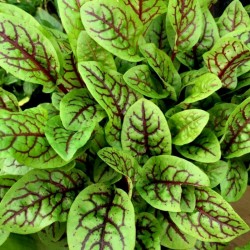
Common Sorrel Seeds (Rumex...
Pret
2,00 €
(SKU: VE 115)
Seeds Gallery EU,
5/
5
<div id="idTab1" class="rte">
<h2 id="short_description_content"><strong>Common Sorrel Seeds (Rumex acetosa)</strong></h2>
<h2><span style="color: #ff0000;"><strong>Price for a Package of 20 seeds.</strong></span></h2>
<p>Of the two kinds of Sorrel cultivated for use as vegetables or salads, Rumex acetosa, the Garden Sorrel, is an indigenous English plant, common, too in the greater part of Europe, in almost all soils and situations. It grows abundantly in meadows, a slender plant about 2 feet high, with juicy stems and leaves, and whorled spikes of reddish-green flowers, which give colour, during the months of June and July, to the grassy spots in which it grows.</p>
<p> </p>
<p>It is generally found in pastures where the soil contains iron.</p>
<p> </p>
<p>The leaves are oblong, the lower ones 3 to 6 inches in length, slightly arrow-shaped at the base, with very long petioles. The upper ones are sessile. They frequently become a beautiful crimson.</p>
<p> </p>
<p>As the flowers increase in size, they become a purplish colour. The stamens and pistils are on different plants. The seeds, when ripe, are brown and shining. The perennial roots run deeply into the ground.</p>
<p> </p>
<p>Sorrel is well known for the grateful acidity of its herbage, which is most marked when the plant is in full season, though in early spring it is almost tasteless.</p>
<p> </p>
<p>The plant is also called 'Cuckoo's-meate' from an old belief that the bird cleared its voice by its agency. In Scotland it is 'gowkemeat.'</p>
<p> </p>
<p>Domestic animals are fond of this and other species of Sorrel. The leaves contain a considerable quantity of binoxalate of potash, which gives them their acid flavour and medicinal and dietetic properties. They have been employed from the most distant time as a salad. In France, Sorrel is put into ragouts, fricassées and soups, forming the chief constituent of the favourite Soupe aux herbes.</p>
<p> </p>
<p>In the time of Henry VIII, this plant was held in great repute in England, for table use, but after the introduction of French Sorrel, with large succulent leaves, it gradually lost its position as a salad and a potherb, and for many years it has ceased to be cultivated.</p>
<p> </p>
<p>John Evelyn thought that Sorrel imparted 'so grateful a quickness to the salad that it should never be left out.' He wrote in 1720:</p>
<p> 'Sorrel sharpens the appetite, assuages heat, cools the liver and strengthens the heart; is an antiscorbutic, resisting putrefaction and in the making of sallets imparts a grateful quickness to the rest as supplying the want of oranges and lemons. Together with salt, it gives both the name and the relish to sallets from the sapidity, which renders not plants and herbs only, but men themselves pleasant and agreeable.</p>
<p> </p>
<p><strong>Culpepper tells us:</strong></p>
<p> 'Sorrel is prevalent in all hot diseases, to cool any inflammation and heat of blood in agues pestilential or choleric, or sickness or fainting, arising from heat, and to refresh the overspent spirits with the violence of furious or fiery fits of agues: to quench thirst, and procure an appetite in fainting or decaying stomachs: For it resists the putrefaction of the blood, kills worms, and is a cordial to the heart, which the seed doth more effectually, being more drying and binding.... Both roots and seeds, as well as the herb, are held powerful to resist the poison of the scorpion. . . . The leaves, wrapt in a colewort leaf and roasted in the embers, and applied to a large imposthume, botch boil, or plague-sore, doth both ripen and break it. The distilled water of the herb is of much good use for all the purposes aforesaid.'</p>
<p> </p>
<p>In this country, the leaves are now rarely eaten, unless by children and rustics, to allay thirst, though in Ireland they are still largely consumed by the peasantry with fish and milk. Our country people used to beat the herb to a mash and take it mixed with vinegar and sugar, as a green sauce with cold meat, hence one of its popular names: Greensauce.</p>
<p> </p>
<p>Because of their acidity, the leaves, treated as spinach, make a capital dressing with stewed lamb, veal or sweetbread. A few of the leaves may also with advantage be added to turnips and spinach. When boiled by itself, without water, it serves as an excellent accompaniment to roast goose or pork, instead of apple sauce.</p>
<p> </p>
<p>'To Stew Sorrel for Fricandean and Roast Meat.</p>
<p>'Wash the Sorrel, and put it into a silver vessel, or stone jar, with no more water than hangs to the leaves. Simmer it as slow as you can, and when done enough, put a bit of butter and beat it well.'</p>
<p> </p>
<p>Unless cooked carefully, Sorrel is likely to disagree with gouty persons, from the acid oxalate of potash it contains, but this may be got rid of if it is plunged for two or three minutes in boiling water, before cooking, this first water being then thrown away.</p>
<p> </p>
<p>In Scandinavia, Sorrel has sometimes been used in time of scarcity to put into bread. The leaves contain a little starch and mucilage, and the root is rather farinaceous.</p>
<p> </p>
<p>The juice of the leaves will curdle milk as well as rennet, and the Laplanders use it as a substitute for the latter.</p>
<p> </p>
<p>The dried root affords a beautiful red colour when boiled and used for making barley water look like red wine, when in France they wish to avoid giving anything of a vinous nature to the sick.</p>
<p> </p>
<p>The salt of Sorrel, binoxalate of potash, is much used for bleaching straw and removing ink stains from linen, and is often sold in the shops under the name of 'essential salt of lemons.'</p>
<h3><strong>Cultivation</strong></h3>
<p>Sorrel of two kinds is cultivated, R. acetosa, or Garden Sorrel, and R. scrutatus, or French Sorrel. Garden Sorrel likes a damp situation, French Sorrel a dry soil and an open situation.</p>
<p> </p>
<p>The finest plants are propagated from seed, sown in March, though it may be sown in any of the spring months. Sow moderately thin, in drills 6 inches apart, and thin out when the plants are 1 or 2 inches high. When the stalks run up in July, they should be cut back. The roots will then put out new leaves, which will be tender and better for kitchen use than the older leaves, so that by cutting down the shoots of some plants at different times, there will always be a supply of young leaves.</p>
<p> </p>
<p>Both varieties are generally increased by dividing the roots, which may be done either in spring or autumn, the roots being planted about a foot apart each way, and watered.</p>
<h3><strong>Parts Used Medicinally</strong></h3>
<p>The leaves both dried and fresh.</p>
<h3><strong>Constituents</strong></h3>
<p>The sour taste of Sorrel is due to the acid oxalate of potash it contains; tartaric and tannic acids are also present.</p>
<h3><strong>Medicinal Action and Uses</strong></h3>
<p>The medicinal action of Sorrel is refrigerant and diuretic, and it is employed as a cooling drink in all febrile disorders.</p>
<p> </p>
<p>It is corrective of scrofulous deposits: for cutaneous tumours, a preparation compounded of burnt alum, citric acid, and juice of Sorrel, applied as a paint, has been employed with success.</p>
<p> </p>
<p>Sorrel is especially beneficial in scurvy.</p>
<p> </p>
<p>Both the root and the seed were formerly esteemed for their astringent properties, and were employed to stem haemorrhage.</p>
<p> </p>
<p>A syrup made with the juice of Fumitory and Sorrel had the reputation of curing the itch, and the juice, with a little vinegar, was considered a cure for ringworm, and recommended as a gargle for sore throat.</p>
<p> </p>
<p>A decoction of the flowers, made with wine, was said to cure jaundice and ulcerated bowels, the root in decoction or powder being also employed for jaundice, and gravel and stone in the kidneys.</p>
<p> </p>
<p>Gerard enumerated eight different kinds of Sorrel - the Garden, bunched or knobbed, Sheep, Romane, Curled, Barren and Great Broad-leaved Sorrel, and said of them:</p>
<p> 'The Sorrells are moderately cold and dry. Sorrell doth undoubtedly cool and mightily dry, but because it is sour, it likewise cutteth tough humours. The juice thereof in summer time is a profitable sauce in many meats and pleasant to the taste. It cooleth a hot stomach. The leaves are with good success added to decoctions, and are used in agues. The leaves are taken in good quantity, stamped and stained into some ale and cooleth the body. The leaves are eaten in a tart spinach. The seed of Sorrell drunk in wine stoppeth the bloody flow.'</p>
</div>
VE 115 (20 S)


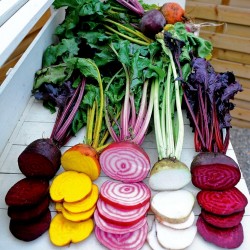
Rainbow Beetroot Seeds
Pret
2,00 €
(SKU: VE 223)
Seeds Gallery EU,
5/
5
<!DOCTYPE html>
<html>
<head>
<meta http-equiv="Content-Type" content="text/html; charset=UTF-8" />
</head>
<body>
<h2><strong>Rainbow Beetroot Seeds</strong></h2>
<h2><span style="color: #ff0000;"><strong>Price for Package of 55+- (1g) seeds.</strong></span></h2>
<p>A visually stunning mixture of five beetroot varieties with superb contrasting outer skins, flesh, stems and leaves! Each variety has a deliciously sweet flavour and they can be enjoyed as mature roots or as tasty 'baby beets'. Delicious whether they are eaten hot or cold, cooked or pickled, Beetroot 'Rainbow Beet' can even be sliced raw into salads for a colourful crunch. Try steaming the tender stems and leaves as an alternative to spinach or Swiss chard. Height: 30cm (12in). Spread: 15cm (6in).</p>
<p> Collection comprises:</p>
<p> Beetroot 'Subeto' - Deep, rich, purple-red roots with purple stems and green leaves.</p>
<p> Beetroot 'Boldor' - A vibrant globe variety with a yellow flesh and orange outer skin. The yellow stems contrast nicely with the bright green leaves.</p>
<p> Beetroot 'Chioggia' - A striking globe variety with red-pink skin and an appealing 'bullseye' formation of red and white rings on the inside fading to soft pink when cooked. Pink stems.</p>
<p> Beetroot 'Albina Vereduna' - Pure white roots with superb flavour, and pale green stems.</p>
<p> Beetroot 'Bull's Blood Scarletta' - A striking variety with dark burgundy-purple leaves, stems and outer skins. When cut open, roots are cerise pink with attractive concentric rings.</p>
<h3><strong>How To Sow</strong></h3>
<p>Direct sow beetroot seeds outdoors from March to July in a weed-free, sunny position in fertile, light, well-drained soil. Sow beetroot seeds thinly in shallow drills at a depth of 3cm (1") and 30cm (12") apart. Germination will usually take 12 to 24 days. When large enough to handle, thin out the seedlings within each row to 10cm (4") apart.</p>
<h3><strong>Aftercare</strong></h3>
<p>When growing beetroot, water as necessary to prevent the soil from drying out and keep the plants cool and moist. This will help to avoid plants running to seed. Roots can be lifted at any time from June to October once they have reached 3cm (1") diameter or more. Harvest any remaining crops before the first frosts. Beetroot can be stored until mid-spring in boxes of moist sand in a frost free shed or garage.</p>
</body>
</html>
VE 223 (1g)

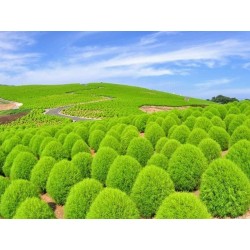
Bassia scoparia Seeds...
Pret
3,85 €
(SKU: UT 5)
Seeds Gallery EU,
5/
5
<h2><span style="font-size:14pt;"><strong>Bassia scoparia Seeds Burning Bush</strong></span></h2>
<h2><span style="color:#ff0000;"><strong><span style="font-size:14pt;">Price for Package of 25 or 100 seeds.</span></strong></span></h2>
<div>
<div>Bassia scoparia (synonym Kochia scoparia) is an annual shrub native to Eurasia. It has introduced populations in many parts of North America, where it is found in grassland, prairie, and desert shrub ecosystems. Its vernacular names include burningbush, ragweed, summer cypress, fireball, belvedere and Mexican firebrush, Mexican fireweed. It may be planted in almost any climate zone in early spring.</div>
<div>Mexican Firebrush (B. S. trichophylla) is a cultivar of B. scoparia that turns bright red in the fall. They easily self-seed and can become a weed if not controlled.</div>
<div>
<div>Biology</div>
<div>The seed of Bassia scoparia is dispersed by wind, water, and especially by the whole plant detaching and tumbling in the wind (see Tumbleweed). The seed does not persist in the soil seed bank, but either germinates or dies within about a year.</div>
<div>Bassia scoparia is a C4 plant, specifically of the NADP-ME type.</div>
<div>Uses</div>
<div>Uses of Bassia scoparia include human food and traditional medicine, forage for livestock, and erosion control.</div>
<div>Tonburi</div>
<div>
<div>The seeds of Bassia scoparia are eaten as a food garnish called tonburi (とんぶり?) (Japanese). Its texture is similar to caviar, and it also is called "land caviar", "field caviar" and "mountain caviar". In Japan, tonburi is a delicacy (chinmi) of Akita prefecture. After harvesting the seeds are dried. To prepare them, the seeds are boiled and soaked in cold water for about a day, then rubbed by hand to remove the outer skin. The seeds are 1–2 mm in diameter, glossy with a black-green color.</div>
<div>Tonburi also is used in traditional Chinese medicine. It may prevent metabolic disorders such as hyperlipidemia, hypertension, obesity and atherosclerosis. In a study of mice fed a high-fat diet, an extract of tonburi did limit obesity. Bassia scoparia seeds contain momordin Ic, a triterpene saponin.</div>
<div>Forage</div>
<div>The plant is a moderately useful forage for livestock, and a potential forage crop for dry lands.However, its use is limited by toxicity when fed in large quantities. Livestock grazing principally on lush stands of Bassia scoparia sometimes experience weight loss, hyperbilirubinemia, photosensitization, and polyuria. When used as the only feed for weeks, Bassia scoparia hay may cause toxicity in cattle.</div>
<div>Other</div>
<div>
<div>Bassia scoparia is planted for ornament or erosion control. It is a known hyperaccumulator of Chromium, Lead, Mercury, Selenium, Silver, Zinc, and Uranium , and as such can be used for phytoremediation.</div>
<div>Systematics</div>
<div>The species was first published in 1753 by Carl Linnaeus, who named it Chenopodium scoparium. In 1809, it was included into the genus Kochia by Heinrich Schrader, and in 1978, into genus Bassia by A.J.Scott. Recent phylogenetic research confirmed, that Kochia has to be included in Bassia. Quelle: Wikipedia</div>
</div>
</div>
</div>
</div>
<table cellspacing="0" cellpadding="0" border="1"><tbody><tr><td colspan="2" width="100%" valign="top">
<p><span style="color:#008000;"><strong>Sowing Instructions</strong></span></p>
</td>
</tr><tr><td valign="top" nowrap="nowrap">
<p><span style="color:#008000;"><strong>Propagation:</strong></span></p>
</td>
<td valign="top">
<p><span style="color:#008000;">Seeds</span></p>
</td>
</tr><tr><td valign="top" nowrap="nowrap">
<p><span style="color:#008000;"><strong>Pretreat:</strong></span></p>
</td>
<td valign="top">
<p><span style="color:#008000;">0</span></p>
</td>
</tr><tr><td valign="top" nowrap="nowrap">
<p><span style="color:#008000;"><strong>Stratification:</strong></span></p>
</td>
<td valign="top">
<p><span style="color:#008000;">0</span></p>
</td>
</tr><tr><td valign="top" nowrap="nowrap">
<p><span style="color:#008000;"><strong>Sowing Time:</strong></span></p>
</td>
<td valign="top">
<p><span style="color:#008000;">all year round </span></p>
</td>
</tr><tr><td valign="top" nowrap="nowrap">
<p><span style="color:#008000;"><strong>Sowing Depth:</strong></span></p>
</td>
<td valign="top">
<p><span style="color:#008000;">1 cm</span></p>
</td>
</tr><tr><td valign="top" nowrap="nowrap">
<p><span style="color:#008000;"><strong>Sowing Mix:</strong></span></p>
</td>
<td valign="top">
<p><span style="color:#008000;">Needs Light to germinate! Just sprinkle on the surface of the substrate + gently press</span></p>
</td>
</tr><tr><td valign="top" nowrap="nowrap">
<p><span style="color:#008000;"><strong>Germination temperature:</strong></span></p>
</td>
<td valign="top">
<p><span style="color:#008000;">18-23 ° C</span></p>
</td>
</tr><tr><td valign="top" nowrap="nowrap">
<p><span style="color:#008000;"><strong>Location:</strong></span></p>
</td>
<td valign="top">
<p><span style="color:#008000;">bright + keep constantly moist not wet</span></p>
</td>
</tr><tr><td valign="top" nowrap="nowrap">
<p><span style="color:#008000;"><strong>Germination Time:</strong></span></p>
</td>
<td valign="top">
<p><span style="color:#008000;">1-2 weeks</span></p>
</td>
</tr><tr><td valign="top" nowrap="nowrap">
<p><span style="color:#008000;"><strong>Watering:</strong></span></p>
</td>
<td valign="top">
<p><span style="color:#008000;">Water regularly during the growing season</span></p>
</td>
</tr><tr><td valign="top" nowrap="nowrap">
<p><span style="color:#008000;"><strong> </strong></span></p>
</td>
<td valign="top">
<p><br /><span style="color:#008000;"><em>Copyright © 2012 Seeds Gallery - Saatgut Galerie - Galerija semena. </em><em>All Rights Reserved.</em></span></p>
</td>
</tr></tbody></table>
UT 5

- Numai online
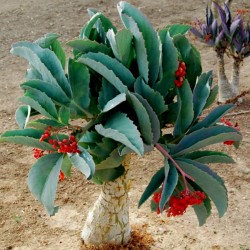
Tree Grape Seeds...
Pret
7,50 €
(SKU: CT 6)
Seeds Gallery EU,
5/
5
<!DOCTYPE html>
<html>
<head>
<meta http-equiv="Content-Type" content="text/html; charset=UTF-8" />
</head>
<body>
<div id="idTab1" class="rte">
<h2 id="short_description_content" class="rte align_justify"><span style="font-size: 14pt;"><strong>Tree Grape Seeds, Wild Grape, Namibian Grape (Cyphostemma juttae)</strong></span></h2>
<h2 class="rte align_justify"><span style="color: #ff0000; font-size: 14pt;"><strong>Price for Package of 3 seeds.</strong></span></h2>
<p>Cyphostemma juttae - the Tree Grape - is a rare, crazy-looking succulent from South Africa and neighboring Namibia. It forms a bizarre canopy of serrated, blue-green leaves that emerge each spring from swollen, tree-like trunks. Each plant takes on a unique shape, with its own "personality". The plants normally grow to 6 or 7 feet tall, but they can potentially reach 12 feet! This is a great species for fans of funky caudex plants!</p>
<p>Cyphostemma juttae is an odd member of the Grape family (Vitaceae). It's a summer-growing species that sheds its leaves during winter, showing off its attractive caudex and stems. The fat, succulent trunks are lined with a papery, peeling bark. The saw-toothed leaves look truly bizarre, like some sort of carpenter's tool! The foot-long leaves have a rubbery texture, and are curled upward along the edges, possibly to catch water.</p>
<p>Flowers appear in the summer, followed by attractive, grape-like berries. Despite their tasty look, the fruits should not be eaten, since they contain a toxin. This is a slow-growing, long-lived plant. While it will take many years to reach maximum size, it is handsome at any age!</p>
<p>Cyphostemma comes from hot, dry areas in southern Africa. It has no problem taking temperatures in the 90s (35°C), although it may need some afternoon shade in hot climates to avoid leaf burn. It can handle winter temperatures in the upper 20s (-2°C), but it's best to protect it from frost. It is easily grown indoors in a pot. Grow it in fast-draining soil, such as cactus mix. It is drought-tolerant, but it appreciates some water and fertilizer during the summer growing season. Despite coming from areas that are dry in winter, it can adapt to wet-winter areas like coastal California.</p>
<p><strong>First scratch the seeds lightly a few times over sandpaper or a nail file. Then soak them in a cup of water for 24 hours. Plant 1 seed per pot. Use small containers about 2" (5 cm) wide. The soil should be well draining, but be able to hold water. A good mix is 1/2 regular potting soil and 1/2 perlite. Cover the seed with 1/2" (1 cm) of soil. Don't compress the soil. After filling the pots, water the soil so that it's uniformly moist. Keep the pots at about 65-75°F (18-24°C). Ensure that the soil surface doesn't dry out, but don't keep the soil soggy either.</strong></p>
<p><strong>Germination is erratic and can take anywhere from days to months. Be patient, as most will eventually sprout. If you have a bag over the pots to retain moisture, remove it immediately after germination or the leaves can rot if they touch it.</strong></p>
<p><strong>Once the seeds sprout, give them filtered sunlight initially until they are a little taller. More tips on growing them are here.</strong></p>
<p><strong>Have fun growing them!</strong></p>
</div>
</body>
</html>
CT 6 (3 S)

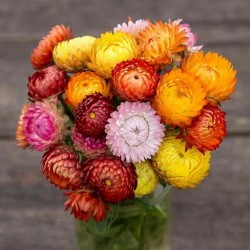
Strawflower Seeds, Golden...
Pret
1,95 €
(SKU: F 57)
Seeds Gallery EU,
5/
5
<div id="idTab1" class="rte">
<h2><span style="font-size:14pt;"><strong>Strawflower Seeds, Golden everlasting (Xerochrysum bracteatum)</strong></span></h2>
<h2><span style="color:#ff0000;font-size:14pt;"><strong>Price for Package of 50 seeds.</strong></span></h2>
<p>Xerochrysum bracteatum, commonly known as the golden everlasting or strawflower, is a flowering plant in the family Asteraceae native to Australia. Described by Étienne Pierre Ventenat in 1803, it was known as Helichrysum bracteatum for many years before being transferred to a new genus Xerochrysum in 1990. It grows as a woody or herbaceous perennial or annual shrub up to a metre (3 ft) tall with green or grey leafy foliage. Golden yellow or white flower heads are produced from spring to autumn; their distinctive feature is the papery bracts that resemble petals. The species is widespread, growing in a variety of habitats across the country, from rainforest margins to deserts and subalpine areas. The golden everlasting serves as food for various larvae of lepidopterans (butterflies and moths), and adult butterflies, hoverflies, native bees, small beetles and grasshoppers visit the flower heads.</p>
<p>The golden everlasting has proven very adaptable to cultivation. It was propagated and developed in Germany in the 1850s, and annual cultivars in a host of colour forms from white to bronze to purple flowers became available. Many of these are still sold in mixed seed packs. In Australia, many cultivars are perennial shrubs, which have become popular garden plants. Sturdier, long-stemmed forms are used commercially in the cut flower industry.</p>
<p><strong>Description</strong></p>
<p>The plant is an erect perennial, or occasionally annual, herb that is simple or rarely branched at its base. It generally reaches 20 to 80 cm (8–32 in) in height, but can have a prostrate habit in exposed areas such as coastal cliffs. The green stems are rough and covered with fine hairs, and are robust compared with those of other members of the genus. The leaves are lanceolate, elliptic or oblanceolate in shape and measure anywhere from 1.5 to 10 cm (0.6–4 in) long and from 0.5 to 2 cm (0.2–0.8 in) wide. They are also covered with cobwebby hairs. Sitting atop tall stems above the foliage, the flower heads range from 3 to 7 cm (1.2–2.8 in) in diameter. Occasionally multiple heads arise from the one stem.[13] Like the flowers of all Asteraceae, they are composed of a central disc which contains a number of tiny individual flowers, known as florets; these sit directly on an enlarged part of the stem known as the receptacle.</p>
<p>Around the disc is an involucre of modified leaves, the bracts, which in Xerochrysum, as in most Gnaphalieae, are petal-like, stiff and papery. Arranged in rows, these bracts curl over and enclose the florets, shielding them before flowering.[16] They create the impression of a shiny and yellow corolla around the disc. The intermediate bracts are sometimes white, while the outer ones are paler and often streaked reddish or brown (a greater variety of colours are found in cultivars).[17] These bracts are papery and dry, or scarious, with a low water content, unlike leaves or flower parts of other plants. They are made up of dead cells, which are unusual in that they have a thin primary and a thick secondary cell wall, a feature only found in sclerenchyma, or structural, cells, not cells of flowers or leaves.</p>
<p>The individual florets are yellow.[17] Those on the outer regions of the disc are female, while those in the centre are bisexual. Female flowers lack stamens and have only a very short tube-shaped corolla surrounding a pistil that splits to form two stigmas, while bisexual or hermaphrodite flowers have a longer corolla, and (as in virtually all members of the family) five stamens fused at the anthers, with the pistil emerging from the center. The yellow corolla and pistil are located above an ovary with a single ovule, and surrounded by the pappus, the highly modified calyx of Asteraceae. It comprises a number of bristles radiating around the florets.[19] Yellow in colour, they persist and are thought to aid in the wind dispersal of the 0.3 cm (0.1 in) long fruit.[19] The smooth brown fruit, known as a cypsela, is 2 to 3 mm long with the pappus radiating from one end.</p>
<p>In the wild, X. bracteatum can be distinguished from X. bicolor in Tasmania by its broader leaves and cobwebby hairs on the stems, and from X. macranthum in Western Australia by the flower head colour; the latter species has white flower heads whereas those of X. bracteatum are golden yellow. Xerochrysum subundulatum from alpine and subalpine areas of New South Wales, Victoria and Tasmania is rhizomatous, and has markedly pointed orange bracts.[20] The eastern Australian species Xerochrysum viscosum may be distinguished by its rough and sticky leaves.</p>
<p><strong>Distribution and habitat</strong></p>
<p>Xerochrysum bracteatum occurs in all Australian mainland states and territories as well as Tasmania.[17] Widespread, it is found from North Queensland across to Western Australia, and in all habitats excluding densely shaded areas.[6] It grows as an annual in patches of red sand in Central Australia,[22] responding rapidly to bouts of rainfall to complete its life cycle.[23] It is common among granite outcrops in southwest Western Australia,[12] and is found on heavier and more fertile soils in the Sydney region, such as basalt-, shale- or limestone-based soils, generally in areas with a high water table.[24] Associated species in the Sydney Basin include blackbutt (Eucalyptus pilularis) in open forest, and the shrubs Empodisma minus and Baloskion australe in swampy areas.[24] It has been reported growing in disturbed soil, along roadsides and in fields in the New England region in the United States.</p>
<p><strong>Taxonomy</strong></p>
<p>French botanist Étienne Pierre Ventenat described the golden everlasting as Xeranthemum bracteatum in his 1803 work Jardin de Malmaison,[4] a book commissioned by Napoleon's first wife Joséphine de Beauharnais to catalogue rare plants that she had collected and grown at the Château de Malmaison.[5] The species name bracteatum is Latin, and refers to the papery bracts (often mistakenly called petals) of the flower heads.[6] Henry Charles Andrews transferred it to the genus Helichrysum based on the morphology of its receptacle in 1805,<[7] and it was known as Helichrysum bracteatum for many years. Leo Henckel von Donnersmarck described it as Helichrysum lucidum in 1806, and Christiaan Hendrik Persoon as Helichrysum chrysanthum in 1807.[2] It was given the name Bracteantha bracteata in 1991,[8] when Arne Anderberg and Laurie Haegi placed the members that are known as strawflowers of the large genus Helichrysum into a new genus Bracteantha, and designated B. bracteata as the type species.[9] However, they were unaware that Russian botanist Nikolai Tzvelev had already placed X. bracteatum in the new, and at the time monotypic, genus Xerochrysum the previous year.[10] This name was derived from the Greek words xeros "dry", and chrysum "golden", likely relating to the nature of the distinctive bracts.[11] There was confusion for a decade with Bracteantha appearing in literature and the horticultural trade until it was clarified in 2002 that the latter name took precedence.[9] Strawflower is the popular name for X. bracteatum in Europe, while in Australia it is known as an everlasting or paper daisy.[6] An alternate name in 19th-century Europe was immortelle.[12] X. bracteatum itself is very variable and may represent several cryptic species.[9] Alternately, the Tasmanian species Xerochrysum bicolor may be combined with it in future taxonomic revisions.</p>
<p>Xerochrysum bracteatum and its relatives belong to the Gnaphalieae or paper daisies, a large tribe within the daisy family, Asteraceae. However, a 2002 molecular study of the Gnaphalieae has indicated the genus Xerochrysum is probably polyphyletic, as the two species sampled, X. bracteatum and X. viscosum, were not closely related to each other.[14] Xerochrysum bracteatum has been recorded hybridising with X. viscosum and X. papillosum in cultivation, and possibly also Coronidium elatum and C. boormanii.</p>
<p><strong>Ecology</strong></p>
<p>The brightly coloured bracts act as petals to attract insects such as hoverflies, native bees and small beetles that pollinate the florets.[16] Grasshoppers also visit the flower heads.[26] The caterpillars of Tebenna micalis have been recorded on this species, as have those of the Australian painted lady (Vanessa kershawi).[27] The tiny fruits are dispersed by wind, and germinate and grow after fire or on disturbed ground.</p>
<p>Experimentation at the Waite Institute of the University of Adelaide showed that flower production was related to increasing day length, and in general, plants produced the most flowers from December to March. Varying planting times or artificially changing light levels might be ways to increase production of flowers outside these months.</p>
<p>The water mould (oomycete) Bremia lactucae has infected commercial crops in Italy and California. In 2002 on the Ligurian coast, widespread infection of several cultivars, most severely 'Florabella Pink' and to a lesser extent 'Florabella Gold' and 'Florabella White', resulted in leaf blistering and the development of chlorotic lesions on the leaves, and white patches on the undersides, particularly in areas of poor ventilation.[29] There was an outbreak of downy mildew in a cultivated crop of Xerochrysum bracteatum in San Mateo County, California in 2006, in which the leaves developed large chlorotic lesions.[30] A Phytoplasma infection damaged X. bracteatum crops in the Czech Republic between 1994 and 2001, causing poor growth, bronzing of foliage and malformation of flower heads. Genetically, the pathogen was indistinguishable from the agent of aster yellows.[31] The root-knot nematode (Meloidogyne incognita) attacks and forms galls on the roots, which leads to the morbidity or death of the plant.</p>
<p><strong>Cultivation</strong></p>
<p>Xerochrysum bracteatum had been introduced to cultivation in England by 1791.[32] German horticulturist Herren Ebritsch obtained material and developed it at his nursery in Arnstadt near Erfurt in Germany. He bred and sold cultivars of many colours from bronze to white to purple, which spread across Europe in the 1850s. The bracts of these early forms tended to remain cupped around the flower head rather than flatten out like the native Australian forms.[6] These were also annual rather than perennial forms. Many were given cultivar names such as 'atrococcineum' (dark scarlet flower heads), 'atrosanguineum' (dark blood-red flower heads), 'aureum' (golden yellow flower heads), 'bicolor' (red-tipped yellow flower heads), 'compositum' (large multicoloured flower heads), 'macranthum' (large rose-edged white flower heads), and 'monstrosum' (flower heads with many bracts), although today they are generally sold in mixed seed for growing as annuals.[33] Some coloured forms of South African Helichrysum are thought to have been introduced to the breeding program, which resulted in the huge array of colours. Xerochrysum bracteatum was one of several species that became popular with European royalty and nobility from the early 19th century, yet were little noticed in Australia until the 1860s, when they became more prominent in Australian gardens.</p>
<p>Most of the cultivars brought into cultivation in Australia in the latter part of the 20th century are perennials.[34] 'Dargan Hill Monarch' was the first of these, and many more have followed.</p>
<p> Profusely flowering, these come in many colours including white, yellow, orange, bronze, pink and red. Their commercial lifespan is generally around three years.[35] Queensland-based company Aussie Winners has a range of compact plants ranging from orange to white known as Sundaze. Plants of this series usually have larger leaves.[37] This range won the Gran premio d'oro at the Euroflora exposition in Geneva in 2001, for the best new plant series in the previous three years. 'Florabella Gold', a member of the Florabella series, won the award for best new pot plant (vegetative) in the Society of American Florists' competition of 1999.[35] The Wallaby cultivars are range of taller forms with narrow leaves and white, yellow or pink flowers.[38] Other commercial ranges include the Nullarbor series, and Queensland Federation daisies, including 'Wanetta Sunshine' and 'Golden Nuggets'.</p>
<p>Xerochrysum bracteatum is easy to grow both from seeds and from cuttings, although named cultivars will only grow true from cuttings. Plants benefit from pruning of old growth in winter to allow for new growth in spring. Dead-heading, or pruning off old flower heads, promotes the production of more flowers.[6] Fresh seed germinates in 3 to 20 days and requires no special treatment.[13] Plants grow best in acid, well-aerated, soils of pH 5.5 to 6.3, with low levels of phosphorus. They are sensitive to iron deficiency, which presents as yellowing (chlorosis) of the youngest leaves while the leaf veins remain green.</p>
<p>Xerochrysum bracteatum can be grown in large pots or window boxes, and is a good pioneer plant in the garden until other plants become more established. Lower growing cultivars are suitable for hanging baskets and border plantings.[38] The flowers attract butterflies to the garden.[40] Dried flowers are long lasting—up to some years—and are used in floral arrangements and the cut flower industry.[37] More robust longer stemmed forms are used for commercial cut flowers.[41] The main factor limiting lifespan of dried flowers is the wilting of stems, so flowers are sometimes wired into arrangements. Immersing flowers in glycerol or polyethylene glycol also lengthens lifespan</p>
</div>
F 57

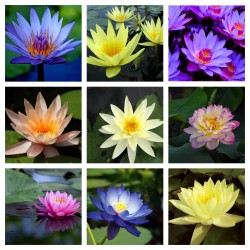
Sacred Lotus Seeds mixed...
Pret
3,50 €
(SKU: F 34)
Seeds Gallery EU,
5/
5
<h2><strong>Sacred Lotus Seeds (Nelumbo nucifera)</strong></h2>
<h2><span style="color:#ff0000;"><strong>Price for Package of 2 seeds.</strong></span></h2>
<p>Nelumbo is a genus of aquatic plants with large, showy flowers resembling the water lily, but not closely related to it. It is commonly called lotus, though this name may be applied to other genera, and there is an unrelated genus Lotus. The generic name is derived from the Sinhalese word Nelum. There are only two known living species in the genus. The sacred lotus (N. nucifera) is native to Asia and is the better known of the two. It is commonly cultivated, and also used in Chinese medicine and cooking. This species is the national flower of Egypt, India and Vietnam. The American lotus (N. lutea) is native to North America and the Caribbean. Horticultural hybrids have been produced between these two geographically separated species. A third, extinct species, N. aureavallis, is known from Eocene fossils from North Dakota, United States.</p>
<p><strong>Classification</strong></p>
<p>There is residual disagreement over which family the genus should be placed in. Traditional classification systems recognized Nelumbo as part of the Nymphaeaceae (water lily) family, but traditional taxonomists were likely misled by evolutionary convergences associated with an evolutionary shift from a terrestrial to an aquatic lifestyle. In the older classification systems it was recognized under the biological order Nymphaeales or Nelumbonales. Nelumbo is currently recognized as its own family, Nelumbonaceae, one of several distinctive families in the eudicot order Proteales. Its closest living relatives, the (Proteaceae and Platanaceae), are shrubs or trees.</p>
<p>The leaves of Nelumbo can be distinguished from those of genera in the Nymphaeaceae as they are peltate, that is they have fully circular leaves. Nymphaea, on the other hand, has a single characteristic notch from the edge in to the center of the lily pad. The seedpod of Nelumbo is very distinctive.</p>
<p><strong>Superhydrophobicity</strong></p>
<p>The leaves of nelumbo are highly water repellent (superhydrophobic). They have given the name to what is called the lotus effect.</p>
<p><strong>Thermoregulation</strong></p>
<p>N. nucifera regulates its temperature in order to benefit insects that are needed for it to reproduce. When the plant flowers, it heats its blossoms to above 30 °C (86 °F) for as long as four days even when the air is as cool as 10 °C (50 °F). The heat releases an aroma that attracts certain insects, which fly into the flower to feed on nectar and pollen. According to Roger Seymour and Paul Schultze-Motel of Australia’s University of Adelaide, the heat also rewards insects with a stable environment that enhances their ability to eat, mate, and prepare for flight.</p>
<div class="rte">
<h2><span><strong>Video:</strong><br /></span></h2>
<h2><span style="color:#f80606;"><strong><a href="https://www.youtube.com/watch?v=CkI9-rhumbs" target="_blank" class="btn btn-default" rel="noreferrer noopener"> How To Grow Lotus From Seeds </a></strong></span></h2>
</div>
F 34





